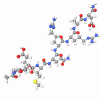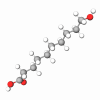Investigations on fragments of deoxyribonucleic acid (DNA) a biologically active functional ingredient, consisting of deoxyribonucleic acid extracted from the gonad tissue of male sturgeon, purified, depolymerized, and neutralized with sodium ions DNA-Na or Sodium DNA and studied. It is the result of some experiments on sodium deoxyribonucleate, carried out in Russia, which had the aim of developing an effective treatment for pathologies induced by ionizing radiation.
The first functional findings occurred in 1986 when it was used to deal with the pathologies caused by the Chornobyl disaster. In the following years, numerous clinical tests aimed at the treatment of different types of lesions and diseases (11 years) confirmed their effectiveness: the observation that nucleotide fragments of DNA with mass molecular structure between 250 and 500 kDa were able to slow down the appearance of wrinkles, paved the way for the studies of Sodium DNA as an active anti-aging ingredient.
In vitro tests over the years, the speed of renewal of skin cells naturally decreases: this gives rise to all the events that characterize skin aging. Using in vitro tests, the regenerating and photoprotective activity of Sodium DNA was evaluated towards two different cell types: keratinocytes and fibroblasts. The results demonstrated that Sodium DNA stimulates cell proliferation and is effective in their protection: in particular, it acts on keratinoliths, stimulating their growth.
The sodium salt of DNA also acts by increasing the vitality of the fibroblasts, which resulted in an increased statistically significant cell proliferation. After topical application of Sodium DNA, it improves the cohesiveness of the superficial layers of the skin and enhances skin thickness and elasticity.Boosting regenerative processes and improving skin hydration, Sodium DNA leaves a significant anti-aging effect on the skin. It is an effective remedy against cellulite and stretch marks, fine lines and deep wrinkles, and UV-induced damage.
Mechanism of Action
The most accredited hypothesis regarding the mechanism of the anti-aging effect sees DNA fragments as donors of purine and pyrimidine bases, key molecules for the vitality of all cells. Sodium DNA crosses cell membranes by pinocytosis, an endocytotic transport mechanism facilitated by the presence of sodium ions associated with polydeoxyribonucleotides.
The cells themselves would then use the 'internalized' Sodium DNA to carry out the metabolism of their own DNA and as a structural basis for the synthesis of nucleic acids and their cofactors. These processes occur very easily in cells that are in extreme metabolic and stress conditions, as in the case of keratinocytes and altered fibroblasts, typical of aged skin.
Sodium DNA, as a consequence of the cellular integration process, exerts a stimulating activity on cellular repair, regeneration of epithelial tissues, and granulation, as well as reducing the symptoms of inflammation and accelerating the healing of skin micro-lesions.










